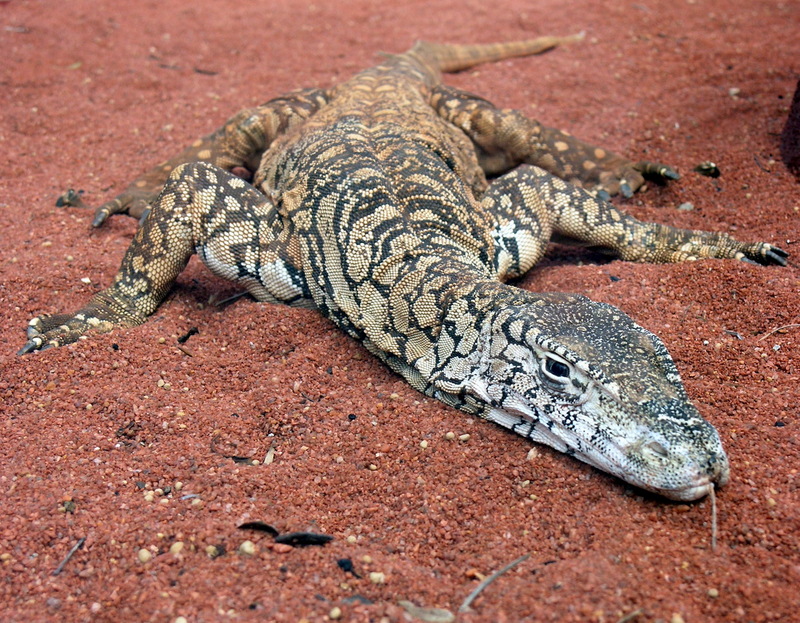|
| Query: varanus giganteus | Result: 4th of 7 | |
Perentie (Varanus giganteus) - Wiki
| Subject: | Perentie (Varanus giganteus) - Wiki
| |

| Resolution: 1209x941
File Size: 619294 Bytes
Date: 2005:09:04 13:34:20
Camera: C8080WZ (OLYMPUS CORPORATION)
F number: f/2.6
Exposure: 10/4000 sec
Focal Length: 140/10
Upload Date: 2007:09:20 19:51:22
|
Perentie
From Wikipedia, the free encyclopedia
[Photo] Perentie Lizard at Perth Zoo in September 2005. Picture taken using an Olympus C8080w. Source: Taken by SeanMack | Permission is granted to copy, distribute and/or modify this document under the terms of the GNU Free Documentation License, Version 1.2 or any later version published by the Free Software Foundation; with no Invariant Sections, no Front-Cover Texts, and no Back-Cover Texts. A copy of the license is included in the section entitled "GNU Free Documentation License". |
The Perentie (Varanus giganteus) is the largest monitor lizard or goanna native to Australia, and third largest lizard on earth, after the Komodo Dragon and the water monitor. Found west of the Great Dividing Range in the arid areas of Australia, they are not a common sight on account of their shyness and remoteness of much of their range from human habitation.
They were a favoured food item among desert Aboriginal tribes, and the fat was used for medicinal and ceremonial purposes.
Description
The lizard can grow up to 2.5 metres (8 ft) in length although the average length is around 1.75-2 metres (5.5-6.5 ft) and weigh up to 15 kg (33 lb). Their rival for third largest lizard is the crocodile monitor. Crocodile Monitors are longer, and often exceed 8 feet in length, but perenties are heavier and bulkier than the crocodile monitor. However, Perenties are relatively lean lizards, less bulky than either the Komodo dragon or the water monitor.
Venom
In late 2005, University of Melbourne researchers discovered that perenties, along with goannas and other monitors, are venomous. Previously, it had been thought that bites inflicted by these lizards were simply prone to infection because of bacteria in the lizards' mouths. According to some Australian wives' tales, the perentie is immune to the bite of venomous snakes. This folklore has not been experimentally tested in light of the discovery that the perentie is itself venomous.
Distribution and habitat
Arid
Rocky with hard packed soil and some other loose rock matter
Behaviour
Perenties are not a common sight in Australia: they are hard to find, and usually evade any human "looker" before the "looker" has a chance to see them.
They can stand on their back legs and tail to gain a better view of the surrounding terrain. This behaviour, known as "tripoding", is quite common to all monitors large and small. Perenties are fast sprinters, running using either all fours legs or just their hind legs.
Diet
Perenties generally forage for their food, but are also known to wait for small animals to come to them. Prey include:
Insects
Reptiles, including their own kin
Birds
Small mammals
Carrion
http://en.wikipedia.org/wiki/Perentie
| The text in this page is based on the copyrighted Wikipedia article shown in above URL. It is used under the GNU Free Documentation License. You may redistribute it, verbatim or modified, providing that you comply with the terms of the GFDL. |
|
Comments |
|---|
| | Guest |
|
Scientific Name: Varanus giganteus (Gray, 1845)
Common Names: Perentie, Perente
Synonyms:
Hydrosaurus giganteus Gray, 1845
Titanzius giganteus Wells & Wellington, 1985
Varanus (Varanus) giganteus Mertens, 1942 |
^o^
Animal Pictures Archive for smart phones
^o^
|
|
|

